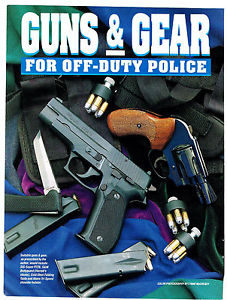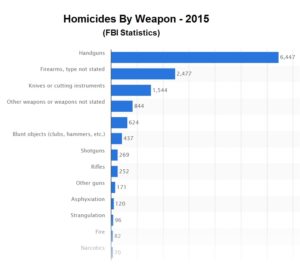Feb
25
 Following the Parkland school shooting, the issues of who’s to blame and “what kind of gun control can we pass now?” have been at the top of Current Events news here in the States for several days. It’s the usual stuff — lots of calls for banning guns, reinforced by slogans and “information” by activists of various sorts (including politicians and the MSM, of course). Unfortunately, much of what is proclaimed by the gun-control crowd is simply not supported by actual facts.
Following the Parkland school shooting, the issues of who’s to blame and “what kind of gun control can we pass now?” have been at the top of Current Events news here in the States for several days. It’s the usual stuff — lots of calls for banning guns, reinforced by slogans and “information” by activists of various sorts (including politicians and the MSM, of course). Unfortunately, much of what is proclaimed by the gun-control crowd is simply not supported by actual facts.
A Facebook friend of mine, Brett K., has been posting a lot of helpful data and common-sense reasoning on the relevant topics, and he was gracious enough to allow me to share some of it. (Saves me a lot of research time! Thanks, Brett!) I chose the following…
—
“On Firearm Owners and Homicides in the U.S.”
I don’t want to get into a big discussion since this topic is very controversial. But I keep hearing a lot of conversations not based in fact. I’m simply providing data relevant to current discussions on this topic.
## While it is not possible to determine the exact number of firearm owners or firearms in the United States, we do have good estimates from a few different surveys, including surveys by Gallup, GSS, and the CDC.
* Firearm Ownership in the U.S. *
Percentage of U.S. Households Owning a Firearm: 45%
Number of People in the U.S. Owning a Firearm: > 147 million
Number of Firearms in the U.S.: 310 million
## The following homicide data is from the FBI Uniform Crime Report for the United States.
* Homicides by Selected Weapon (Annual) *
Handguns: 6,447
Rifles: 252
Knives: 1,544
Blunt Objects: 437
Hands/Feet: 624
…
* Homicide Offenders by Age (Annual) *
17-19: 1,263
20-24: 2,448
25-29: 1,814
…
## The following data is from the U.S. Centers for Disease Control.
* Selected Annual Death Rates *
Alcohol: 88,000
Tobacco: 480,000
Vehicles: 34,000
…
## President Obama ordered the Centers for Disease Control and Prevention to assess the research on gun violence and recommend future studies. That 2013 report was prepared by the Institute of Medicine and the National Research Council. Here are some of the findings.
– Crime in general including firearm homicides have been on the decline since the 1990s.
– “Public mass shootings of the type that occurred at Sandy Hook Elementary School accounted for a very small fraction of all firearm-related deaths [in the past 30 years].”
– “Defensive use of firearms ranges from about 500,000 to more than 3 million incidents per year.”
– “Studies that directly assessed the effect of actual defensive uses of guns (i.e., incidents in which a gun was ‘used’ by the crime victim in the sense of attacking or threatening an offender) have found consistently lower injury rates among gun-using crime victims compared with victims who used other self-protective strategies.”
## Here are a few points to consider about the data presented above.
– There are 310 million firearms in the United States owned by over 147 million citizens. The annual firearm homicide rate with rifles is 252.
– If you assume every firearm homicide was committed by a legal firearm owner and a different legal firearm owner committed each homicide, then firearm homicides were committed by about 0.07% of legal firearm owners. The reality is that many firearm homicides are committed with illegal firearms, therefore the firearm homicide rate for legal firearm owners is actually less than 0.07%.
– Twenty to 24-year-olds commit about twice as many homicides as 17-19-year-olds. If a person is attempting to reduce the homicide rate by raising the legal age for firearm ownership, then the legal age should be raised to 25 — not 21.
—
Very interesting. He pursues that last idea a bit in the next section…
—
“On Lowering the Legal Age to Purchase a Firearm”
Many people are supporting a change in federal law to raise the minimum age for legally purchasing a rifle from 18 to 21. President Trump, several Republicans in Congress, and some in the conservative media are supporting the idea. The only reasons given for this change are that the Florida shooter was under 21, and 18-year-olds today are not mature enough to buy rifles.
We have federal firearm laws and state firearm laws. These laws distinguish between purchasing a firearm and owning a firearm. Federal firearm laws already set the minimum age for handgun purchases to 21. They already forbid handgun ownership for those under 18. However, by federal law, a person between 18 and 21 can own a handgun that someone else purchased.
Federal law says a person must be at least 18-years-old to buy a rifle, but there are no federal laws restricting the age for rifle ownership. There are some state laws with minimum ages for rifle ownership but not federal laws. The new proposals are for increasing the federal age for rifle purchases. So far, no one has suggested they create a federal age for rifle ownership.
According to the FBI Uniform Crime Report, the homicide rate for rifles was 252 in 2015, whereas the homicide rate for handguns was 6,447 that year. Changing the rifle purchasing age will have almost no effect on the overall firearm homicide rate. Given there is no federal minimum age for rifle ownership, a new purchasing law would essentially be pointless.
However, let’s give them the benefit of the doubt and make some assumptions in their favor. Let’s assume all rifle homicides were committed by people who legally purchased their rifle. Let’s assume raising the age for legally purchasing a rifle could somehow lower the overall homicide rate. Would raising the purchase age for rifles to 21 have the desired effect?
The FBI homicide statistics include age ranges for homicide offenders. There is overlap in the ranges so you have to use some estimation to determine the number of 18-20-year-olds who commit murder each year.
We know there are less than 1,981 homicide offenders who are 18-20-years-old since that is how many offenders are 18-22-years-old. The 18-22 range includes 21 and 22-year-olds who would not be affected by a new law.
We know there are more than 1,263 homicide offenders in the 18-20-year-old range since that is the number of 17-19-year-old offenders. The 17-19 range includes 17-year-olds and does not include 20-year-olds.
Based on these numbers, we can estimate that about 1,500 of the 15,326 total homicides (from all causes including knives, blunt objects, hands/feet, etc.) were committed by 18-20-year-olds. The single largest age range for homicide offenders was 20-24 with a total of almost 2,500 homicides. About 60% more homicides are committed by 20-24-year-olds than 18-20-year-olds.
Should they raise the legal age for purchasing a rifle to 21 thereby potentially affecting the homicide rate of 1,500 per year? Or should they raise the legal age for purchasing a rifle to 25 thereby potentially decreasing the homicide rate of 4,000 per year? Why not raise the legal age to 25 instead of 21 since that could potentially cut homicides by 25%?
I would not be in favor of raising the legal age for purchasing a rifle to 21, but I could see a potential benefit in raising the age to 25 -— given our initial assumptions. At least that would be a decision based on the data.
I would have one caveat. They want to raise the age for purchasing rifles because they do not believe 18-year-olds today are mature enough to buy them. If they are not mature enough to buy a rifle, they are most certainly not mature enough to decide the direction of the United States with their votes. I would support raising the legal age to buy a rifle to 25 as long as they also raised the legal voting age to 25.
Raising the legal age for rifle purchases beyond 18 repeats one of the contradictions we have with a drinking age of 21. An 18-year-old can be drafted or join the military. They will be handed a rifle and trained to kill people. They may very well risk their lives in a foreign country while serving the U.S. They may very well shoot and kill enemies with the rifle they are given. But, if the age for rifle purchases were raised to at least 21, they would not legally be allowed to buy a drink or own a rifle. They could serve their country and kill enemies, but they couldn’t have a beer or buy their own hunting rifle. Doesn’t make much sense.
—
 As I pointed out to Brett re that last part, same goes for law enforcement recruits as for military. (Of course, the minimum age to even enter the police academy is 20 or 21, depending on the state.) This would mean that young, off-duty cops and military personnel would not be allowed to buy/carry their own rifles. Why shouldn’t such good-guys-with-guns, who are well-trained in the use of firearms, be allowed to purchase a rifle and carry it in public, where they can potentially use it against bad-guys-with-guns? (Concealed carry with a handgun is much more common, but there are places where carrying a rifle in public is legal.)
As I pointed out to Brett re that last part, same goes for law enforcement recruits as for military. (Of course, the minimum age to even enter the police academy is 20 or 21, depending on the state.) This would mean that young, off-duty cops and military personnel would not be allowed to buy/carry their own rifles. Why shouldn’t such good-guys-with-guns, who are well-trained in the use of firearms, be allowed to purchase a rifle and carry it in public, where they can potentially use it against bad-guys-with-guns? (Concealed carry with a handgun is much more common, but there are places where carrying a rifle in public is legal.)
See, I don’t buy (pardon the pun) this whole bid to raise the age of purchasing a rifle (or any other firearm). First, as Brett pointed out, it would likely have little-to-no impact on the actual homicide statistics, especially since most firearms used in homicides are not obtained legally. Second, “underage” people can still receive/possess firearms purchased by others. Third, it seems to me that real solutions involve arming good citizens, eliminating gun-free zones, improving mental-health treatment, and addressing the socio-cultural and worldview issues that lead some young people to be so cavalier about taking the lives of others.

















